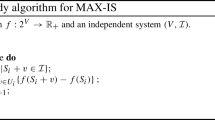Abstract
In this paper, we study the problem of maximizing a monotone non-decreasing submodular function \(f :2^\Omega \rightarrow {\mathbb {R}}_{+}\) subject to a cardinality constraint, i.e., \(\max \{ f(A) : |A| \le k, A \subseteq \Omega \} \). We propose a deterministic algorithm based on a new greedy strategy for solving this problem. We prove that when the objective function f satisfies certain assumptions, the algorithm we propose can return a \(1 - \kappa _f (1 - \frac{1}{k})^k\) approximate solution with O(kn) value oracle queries, where \(\kappa _f\) is the curvature of the monotone submodular function f. We also show that our algorithm outperforms the traditional greedy algorithm in some cases. Furthermore, we demonstrate how to implement our algorithm in practice.
Similar content being viewed by others
Notes
Note that \( 1 - \kappa _f e^{-1} > \frac{1}{\kappa _f} (1 - e^{-\kappa _f} )\) holds for any \(\kappa _f \in (0,1)\).
We will explain this assumption in section 3.
To see this, one should refer to Lemma 3, which explains the relation between \(\Psi _i\) and the marginal gain of the distorted objective function \(\Phi _i\).
References
Ageev, A., Hassin, R., Sviridenko, M.: A 0.5-approximation algorithm for max dicut with given sizes of parts. SIAM J. Discret. Math. 14(2), 246–255 (2001)
Conforti, M., Cornuéjols, G.: Submodular set functions, matroids and the greedy algorithm: tight worst-case bounds and some generalizations of the rado-edmonds theorem. Discret. Appl. Math. 7(3), 251–274 (1984)
Feige, Uriel: A threshold of ln n for approximating set cover. J. ACM (JACM) 45(4), 634–652 (1998)
Feldman, M.: Guess free maximization of submodular and linear sums. Algorithmica 83(3), 853–878 (2021)
Frieze, A., Jerrum, M.: Improved approximation algorithms for maxk-cut and max bisection. Algorithmica 18(1), 67–81 (1997)
Grötschel, M., Lovász, L., Schrijver, A.: The ellipsoid method and its consequences in combinatorial optimization. Combinatorica 1(2), 169–197 (1981)
Harshaw, C., Feldman, M., Ward, J., Karbasi, A.: Submodular maximization beyond non-negativity: Guarantees, fast algorithms, and applications. In International Conference on Machine Learning, pages 2634–2643. PMLR, 2019
Iwata, S., Fleischer, L., Fujishige, S.: A combinatorial strongly polynomial algorithm for minimizing submodular functions. J. ACM (JACM) 48(4), 761–777 (2001)
Kempe, D., Kleinberg, J., Tardos, É.: Maximizing the spread of influence through a social network. In Proceedings of the ninth ACM SIGKDD international conference on Knowledge discovery and data mining, pages 137–146, 2003
Khuller, S., Moss, A., Naor, J.S.: The budgeted maximum coverage problem. Information Process. lett. 70(1), 39–45 (1999)
Krause, A., Guestrin, C.: Near-optimal observation selection using submodular functions. In AAAI 7, 1650–1654 (2007)
Krause, A. , Guestrin, C. E.: Near-optimal nonmyopic value of information in graphical models. arXiv preprint arXiv:1207.1394, 2012
Krause, A., Singh, A., Guestrin, C.: Near-optimal sensor placements in gaussian processes: theory, efficient algorithms and empirical studies. J. Mach. Learn. Res. 9, 235–284 (2008)
Lin, H., Bilmes, J.: Multi-document summarization via budgeted maximization of submodular functions. In Human Language Technologies: The 2010 Annual Conference of the North American Chapter of the Association for Computational Linguistics, pages 912–920, 2010
Nemhauser, G.L., Wolsey, L.A., Fisher, M.L.: An analysis of approximations for maximizing submodular set functions-i. Math. Progr. 14(1), 265–294 (1978)
Schrijver, A.: A combinatorial algorithm minimizing submodular functions in strongly polynomial time. J. Comb. Theory Series B 80(2), 346–355 (2000)
Sviridenko, M., Vondrák, J., Ward, J.: Optimal approximation for submodular and supermodular optimization with bounded curvature. Math. Oper. Res. 42(4), 1197–1218 (2017)
Author information
Authors and Affiliations
Corresponding author
Additional information
Publisher's Note
Springer Nature remains neutral with regard to jurisdictional claims in published maps and institutional affiliations.
This research was supported by the National Natural Science Foundation of China under Grant Numbers 11991022 and 12071459 and the Fundamental Research Funds for the Central Universities under grant number E1E40107.
Rights and permissions
About this article
Cite this article
Lu, C., Yang, W. & Gao, S. A new greedy strategy for maximizing monotone submodular function under a cardinality constraint. J Glob Optim 83, 235–247 (2022). https://doi.org/10.1007/s10898-021-01103-1
Received:
Accepted:
Published:
Issue Date:
DOI: https://doi.org/10.1007/s10898-021-01103-1




